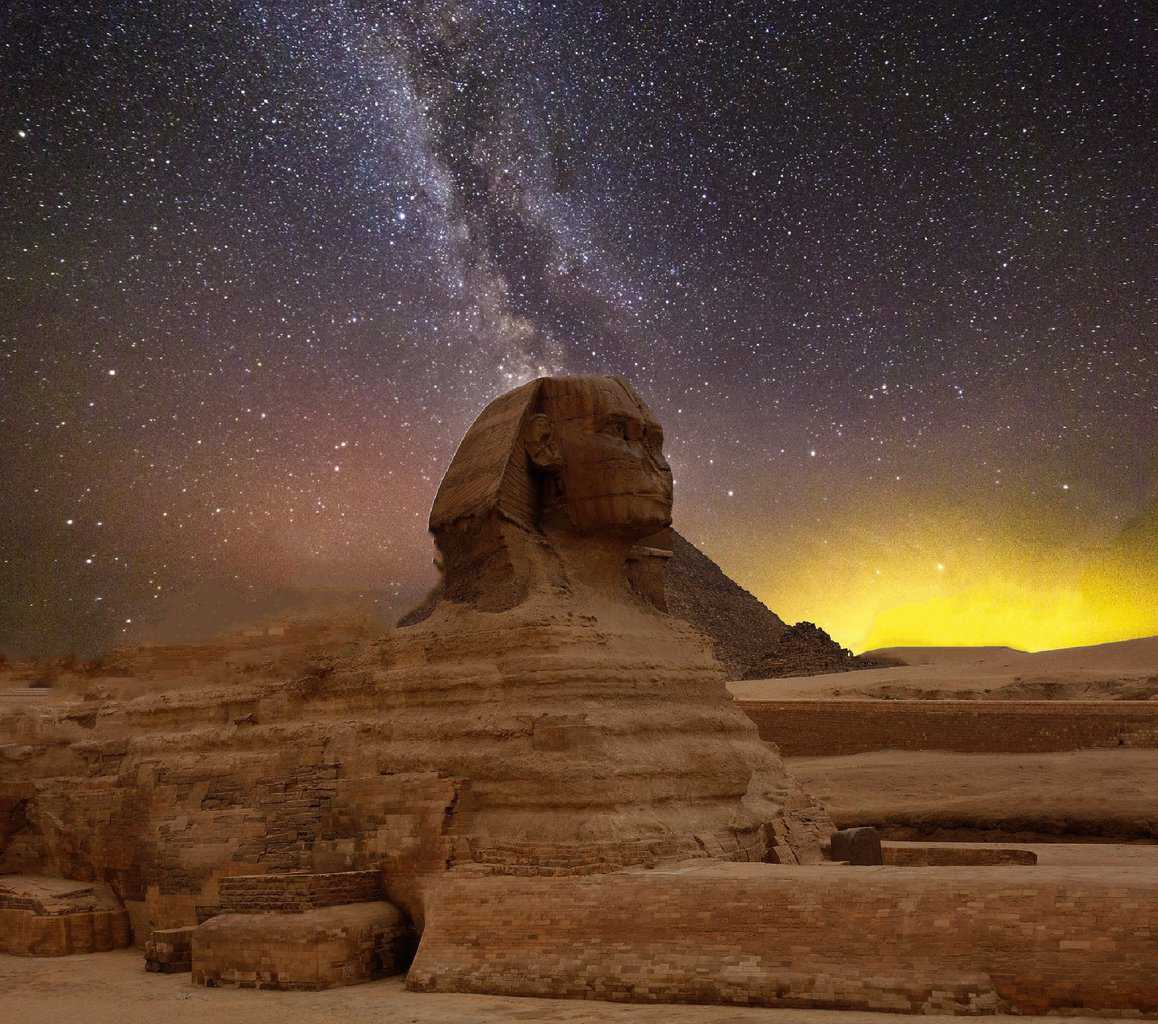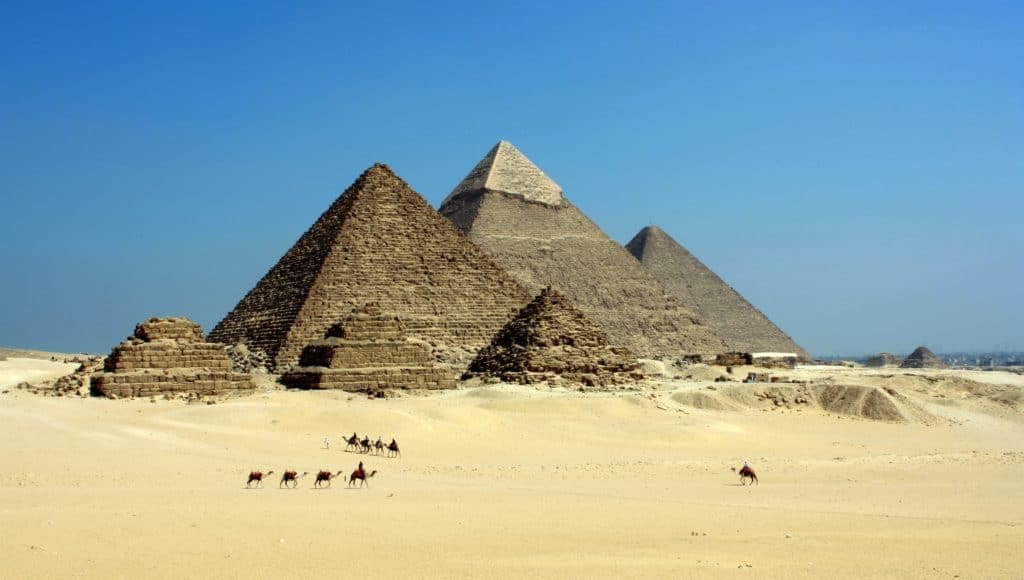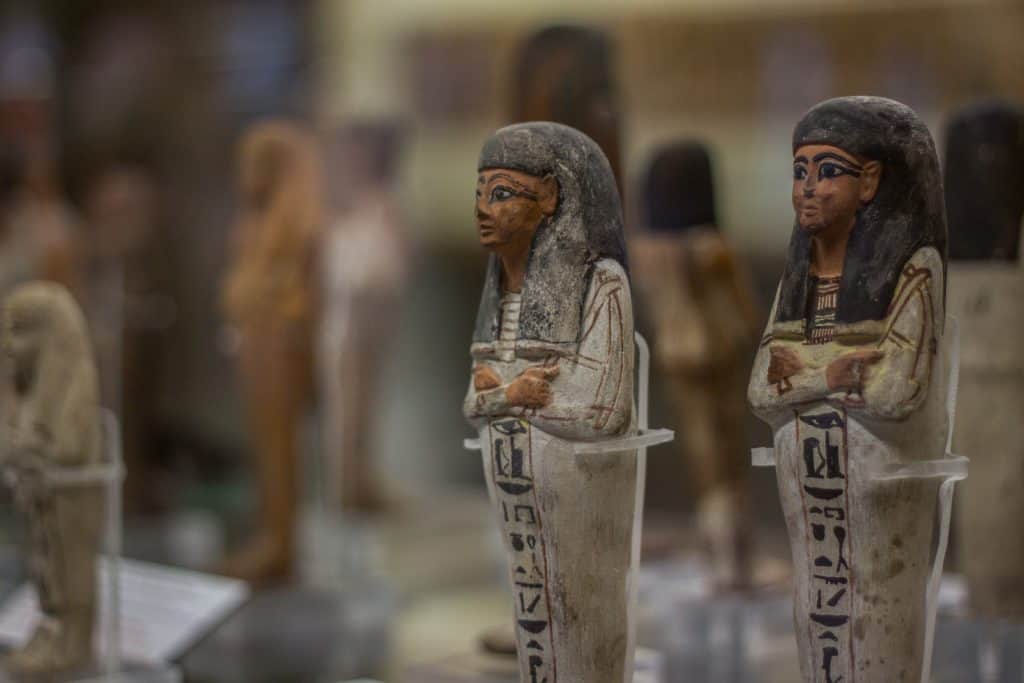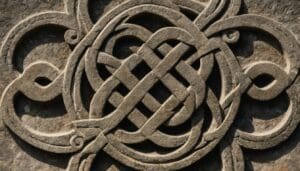Amazing Ancient Egypt-30 Centuries of the Egyptian Empire

Updated On: December 11, 2023 by Ciaran Connolly
When you think of Ancient Egypt you automatically think about the magnificent pyramids and powerful pharaohs. But what else did the Ancient Egyptians get up to?
In this article we are going to do a dive into all things Ancient Egypt, from their food and clothes to their gods and rulers.

Table of Contents
- History of Ancient Egypt
- Ancient Egyptian Clothing
- Ancient Egyptian Pharaohs
- Pyramids of Egypt
- Ancient Egyptian Burials
- Egyptian Hieroglyphics
- Egyptian Deities
- Ancient Egyptian Cats
- Ancient Egyptian Inventions
History of Ancient Egypt
For over 3000 years the Ancient Egyptian civilisation was one of the most powerful and greatest civilizations in the world. Upper Egypt and Lower Egypt, were unified by King Menes around 3150 B.C to create the great Egyptian state. For this reason, King Menes then became the first pharaoh known as Narmer.The civilization of ancient Egypt was located along the Nile River in northeast Africa.With three major periods associated with Ancient Egypt, the Old Kingdom, Middle Kingdom and New Kingdom, the Ancient Egyptians have a long, rich and interesting history. We know so much about the Ancient Egyptians today thanks to the amount of artefacts, objects and monuments that have been preserved.
The Old Kingdom
The Old Kingdom was the first period of Ancient Egypt and it began with the third dynasty of pharaohs.The Old Kingdom spanned from around 2600-2180 B.C, which included the third to the sixth dynasties. It is also known as the “Age of Pyramid” as it was during this period that King Sneferu perfected the art of pyramid building and the famous Great Pyramids of Giza were built during kings Khufu, Khafre, and Menkaure reigns.The Great Sphinx of Giza was also built during Khafre’s reign, who closely associated himself with the god Horus. At the end of the 6th Dynasty, a period of social unrest and reformation emerged known as The First Intermediate Period. This period lasted from around 2181-2040 B.C during which Egyptian districts were ruled by local magistrates or rulers who made their own laws. During this time, which ran from the seventh to the tenth dynasty, the scale of wealth that was previously only available to the upper class became more widespread.
The Middle Kingdom
The Middle Kingdom began with the start of the 12th dynasty which marked the end of the first intermediate period. This period lasted from about 2040-1640 B.C. The Middle Kingdom reached its peak under Amenemhet III and began declining under the reign of Amenemhat IV. During this time, Egypt had it first female ruler, sister and regent of Amenemhat IV, Queen Sobekneferu, who was the last ruler of the 12th dynasty. The 13th dynasty was another unsettled period in Egyptian history, during which many kings failed to hold power. As a consequence of this unstable leadership, the Second Intermediate Period began. This lasted from roughly 1780-1560 B.C. and during this time a line of foreign rulers known as the Hyksos took advantage of Egypt’s instability and took control over the country.
The New Kingdom
The New Kingdom spanned from around 1560-1085 B.C. and it was a time known for its monumental architecture and honouring of the gods and pharaohs with statues, through the 18th to the 20th dynasty. It was a period of nearly 500 years of economic prosperity and political stability. During this time, the country went on to establish the world’s first great empire, which stretched from Nubia to the Euphrates River in Asia. The controversial 18th dynasty ruler Amenhotep IV, undertook a religious revolution during this period, in which he disbanded the priesthoods dedicated to Amon-Re and instead forced the exclusive worship of another sun-god, Aton. After the New Kingdom went into decline, Egypt split into smaller parts and was eventually taken over by stronger neighbours, in particular the Roman Empire took over in 31 B.C. and later in A.D. 640, Muslim warriors took over Egypt.
Ancient Egyptian Clothing
We are all familiar with what Ancient Egyptian clothing was like from the reliefs and painted scenes that they left behind for us and the many movies and programmes that have depicted them. Let’s have a look at the different kinds of clothing that the Egyptians wore and materials they used. The Ancient Egyptians were quite particular about cleanliness and their personal appearance.Those who didn’t keep themselves looking well were looked at as inferior.
Clothing
The Ancient Egyptians wore clothing made from linen.This is a light and cool fabric that we still use today. Line was the perfect material for the hot climate of Egypt. Linen was made from the fibres of the flax plant. Egyptian workers would have to spin the fibres into thread and they would then use a loom to wove it into linen fabric that could be used to make clothing. It was a long and laborious process. All Egyptians wore linen, but the type of linen worn depended on a person’s status.Wealthy people wore softer linen clothing which was made from thin flax fibres, while the poorer in society and peasants wore quite rough linen clothing that was made using thicker fibres.
Men
Most Egyptian men wore a kilt made from linen. Egyptian kilts were a linen rectangle shaped skirt that wrapped around the body and was tied with a belt, they were similar to the kilts that the Scottish wear. Kilts were cool and easy to wear in Egyptian weather. Working-class Egyptian men would have worn loincloths or short kilts and some wore garments, similar to a shirt, tied with a sash at the waist.
Women
Women would have worn long and fitted dresses made from linen. Wealthier women wore intricate dresses made from beads. Some dresses even had pieces of jewellery on the hem that made a sound, like bells when they walked. Working-class Egyptian women wore full-length wraparound gowns.
Children
We could not imagine this now but in Ancient Egypt, it was normal for children to not wear clothes.Children usually didn’t wear any clothing until the age of six. Although children didn’t wear clothes, they did wear jewellery, such as bracelets, earrings and necklaces. Older children would wear clothing similar to that of their parents.
Egyptian Shoes
Straw and leather were the two main materials used to make Egyptian shoes. From the many wall reliefs that the Egyptians painted we know that most Egyptians didn’t wear shoes and instead chose to go barefoot. However, if someone wanted protection for their feet, sandals were the shoe trend during Ancient Egyptian times. Most Egyptians would have worn sandals made of straw, while wealthier Egyptians wore sandals made of leather.
Ancient Egyptian Beauty

I don’t know about you but when I think of Egyptian makeup I picture Elizabeth Taylor as Cleopatra with big dark eyeshadow and dramatic eyeliner. During Ancient Egyptian times, Egyptians wore eye make-up to make them look beautiful and to also protect their eyes from the glare of the sun. Makeup was worn by both Egyptian men and women. Egyptians mostly used kohl and malachite powder for eye makeup. Kohl was a black paint that protected their eyes and malachite powder made the eyes appear larger. Black was mostly used around the eyes in an almond or feline-inspired shape. They would have also covered their skin with creams and oils.They used beauty tools that look similar to the ones we use today such as, mirrors, razors, tweezers and tubs to hold their eye-makeup.
Ancient Egyptian Hairstyles
When you picture Egyptians you imagine straight black hair with fringes adorned with beads. But what exactly were the Egyptian hairstyles like? Ancient Egyptian hairstyles changed throughout the different periods, similar to how our hairstyles change throughout the decades.
Men
The most common hairstyle for men was to have their hair cut up short or to have their heads shaven. It was also very common for men to wear short wigs with elaborate jewels. Hairstyles were important to Ancient Egyptians and changed over time.
Women
Women wore their hair short and long throughout the different periods of Ancient Egypt. Many women also wore large wigs and the wealthy would have had jewels and beads on their wigs.
Children
Both boys and girls wore their hair in a braid on the right side of their head. This hairstyle was called the “sidelock of youth”.They kept their hair long in this braid until they became an adult. Once they became an adult, they had the choice to shave their head or wear it in shorter braids, as a sign that they were growing up. At 14 years old, children would have been considered adults.
Ancient Egyptian Jewellery
Both Egyptian men and women wore jewellery. Amulets were a type of jewellery that were considered as good luck charms and believed to protect the owners. Jewellery was used by wealthier Egyptians to enhance their appearance. The kind of jewellery worn by Egyptians were earrings, bracelets and necklaces.
Ancient Egyptian Pharaohs
Throughout Ancient Egyptian times many pharaohs ruled. Some have gone down in history as well known powerful figures while others have been forgotten in the years gone by. Let’s have a look at some of the more better known Ancient Egyptian Pharaohs.
Hatshepsut
Hatshepsut may not be the first pharaoh to come to mind when think about Ancient Egyptian times, however she was one of the greatest pharaohs that the Egyptian civilisation had. Although not the first female Pharaoh, Hatshepsut did hold the longest reign of any female Pharaoh. Hatshepsut road to pharaoh was certainly not ordinary, and as a woman during Ancient Egyptian times this is no surprise. Even though she was the daughter of a king, she didn’t inherit her rulership . At the time only sons were allowed to succeed their fathers, however when King Thutmose I died, Hatshepsut was his only heir.To fix this problem, Hatshepsut married her half-brother, Thutmose II to allow him to become pharaoh.
Thutmose II had poor health and wasn’t pharaoh for very long. His heir, Thutmose III, who was Hatshepsut’s stepson, became pharaoh instead. As Thutmose III was too young to rule, Hatshepsut stepped in a coruler around 1473 B.C. The two would successfully rule together for over 20 years.The only male heir to the throne was a young boy that was Hatshepsut’s nephew Thutmose III.In order for people to accept her as pharaoh, Hatshepsut dressed like a pharaoh. She often wore the pharaoh’s headdress with a cobra and a fake beard.During her reign, she established excellent trade relationships with many foreign countries, making Egypt a rich nation. She also built magnificent buildings during her time. Her time of rule was a time of peace and prosperity.
Menes
The history of Menes is quite unclear and many historians find it hard to distinguish between the fact and fiction of the legendary Egyptian ruler, similar to Romulus and Remus of Ancient Rome. Over 5,000 years ago, Menes became ruler of Egypt and is now considered as the very first Egyptian Pharaoh. During this time there was rivalry between Upper and Lower Egypt. Menes had successfully ruled over Upper Egypt and decided to conquer Lower Egypt and combine the two. He is credited for joining Upper and Lower Egypt into a single monarchy known as “The Two Lands”, which became known as Egypt. He also founded the capital city of Ancient Egypt during the Old Kingdom, Memphis. Menes ruled over Ancient Egypt for 62 years until he was apparently killed by a hippopotamus.
Khufu
Pharaoh Khufu was the second pharaoh of the 4th dynasty of the Old Kingdom and took the throne at 20 years of age. He ruled over Egypt for 24 years. Khufu is best known for building the Great Pyramid of Giza, also known as the ‘Pyramid of Khufu’.He had built the pyramids to serve as his tomb and acted as his stairway to heaven and passage to eternal life. It took almost 20 years for Khufu’s incredible tombs to be built and today they are considered as one of the 7 Wonders of the World. The architect of Khufu’s pyramid was Hemiunu, who was the grandson of King Snefru, making him a member of royalty. During his reign, Khufu had many wives and he had a total of 24 children, 9 sons and 15 daughters.
Tutankhamun
Tutankhamun is by far the most recognised and well known Egyptian pharaoh, however it is not because of his incredible rulership and achievements but because of the historic discovery of his famous tomb. The Egyptian pharaoh was nicknamed the Boy King as he was only nine years old when he became king. Tutankhamun only ruled for 10 years as he died at the young age of 19 years. King Tut’s father was the pharaoh Akhenaten,who had got rid of the idea of many gods and changed worship to one god: Aten, the sun god. For this reason, Tutankhamun was originally named Tutankhaten. In defiance, Tutankhamun changed his name when he became king. During his short reign, Tutankhamun was very influenced by his advisors and he changed many of the laws his father had implemented. In particular he brought back worship to many gods and began rebuilding some temples to the gods. Tutankhamun had no heirs when he died.
In 1922, British archaeologist Howard Carter discovered the burial tomb of King Tutankhamun in the Valley of the Kings.Throughout the years, many Ancient Egyptian tombs were emptied and plundered because of all the gold inside.This was the first tomb that still had everything inside, untouched and intact. This discovery gave us a great insight into what Pharaohs brought with them to the afterlife.His golden coffin was buried in a tomb in the Valley Of The Kings and surrounded by 5,000 priceless treasures. The discovery revealed that Tutankhamun was buried inside three coffins, with the last one being made of gold and the one that held his mummified body. Historians still do not know how exactly Tutankhamun died as his mummy is far too fragile to examine and no stories recount it. Among the riches found in his tomb were golden shrines, jewellery, statues, a chariot, weapons and clothing. Tutankhamun’s golden burial mask was one of the most magnificent finds.
Cleopatra
Cleopatra is probably one of the most well known figures of Ancient Egypt. She is known as the last Pharaoh of Egypt. Cleopatra’s history is an interesting one, especially her connections with Ancient Rome. Cleopatra was born in 69 bce in the city of Alexandria in Egypt. Her family originally came from Macedonia in Europe and had ruled Egypt for 300 years. They were known as the Ptolemy dynasty, which was established by the Greek ruler Alexander the Great. Cleopatra and her brother, Ptolemy XIII, became rulers together after their father died in 51 bce. When Cleopatra was eighteen years old her father died in 51B.C. He left the throne to both her and her younger brother, Ptolemy XIII. Cleopatra and her ten-year-old brother were married and were to rule Egypt together. As Cleopatra was much older she took control as main ruler of Egypt. However, as her brother grew older he wanted more power and he earned more followers who soon drove Cleopatra from power. Ptolemy XIII then became sole ruler of Egypt.
In 48 B.C, Roman ruler Julius Caesar came to Egypt. Cleopatra convinced Caesar to help her win back the throne. Caesar defeated Ptolemy’s army at the Battle of the Nile and Ptolemy was killed. Cleopatra then took back power and once again coruled Egypt but this time with her younger brother, Ptolemy XIV. Cleopatra and Julius Caesar soon fell in love and had a child named Caesarion, meaning little Caesar.
Caesarion became co-ruler of Egypt when he was three years old with Cleopatra. Shortly after, in 44 BC, Julius Caesar was assassinated and three leaders emerged in Rome to rule. One of these rulers was Marc Antony and in 41 BC, he met and fell in love with Cleopatra. The two formed a military alliance against another of Rome’s leaders, Octavian. Octavian was the legal heir of Julius Caesar, which angered Cleopatra as she wanted her son, Caesarion to be heir and become ruler of Rome. A battle between Cleopatra and Marc Anthony’s forces and Octabions erupted at the Battle of Actium in 31 B.C. Antony and Cleopatra were defeated by Octavian and had to retreat to Egypt. The mystery of Cleopatra’s death is unclear but it is said that she killed herself by allowing a poisonous cobra to bite her after learning of Marc Anthony’s death. Cleopatra’s death brought an end to the Ptolemy dynasty and the Ancient Egyptian Empire. Soon after the Egyptian Empire was taken over by the Roman Empire, headed by Octavian who became known as Emperor Augustus.
The Great Pyramids of Egypt
The Great Pyramid of Giza was built as the burial site for great pharaohs and intended to last an eternity and they have done just that. Nearly 5000 years after they were built, these magnificent structures still stand today. Pharaoh Khufu first began the construction of the Great pyramid in order to prepare for the next world when he died.The Great Pyramid of Giza is a part of a collection of three pyramids known as the Giza Necropolis, which includes the Pyramid of Menkaure and the Pyramid of Khafre. The Giza Necropolis also has the famous Great Sphinx located close by. These pyramids were filled with all the things each ruler would need to guide and sustain himself in the next world, including stuffed animals, particularly cats, gold, clothing and statues.
The Great Pyramid of Giza
When the pyramid was built, it stood at around 481 feet tall. However, due to erosion and the removal of the top piece, the pyramid now stands at around 455 feet tall. It is over 700 feet in width and it covers an area of over 13 acres.It was built using about 2.3 million stone blocks and it took 20,000 workers around 20 years to complete. Historians are unsure as to how exactly the Egyptians actually built the pyramids. There were three main rooms in the Great Pyramid, the King’s Chamber, the Queen’s Chamber, and the Grand Gallery.
Pyramid of Khafre and Menkaure
The two other major pyramids at Giza are the Pyramid of Khafre and the Pyramid of Menkaure. The Pyramid of Khafre was built by Khufu’s son, Pharaoh Khafre. It is the second largest pyramid of the three. The Pyramid of Menkaure was built for Khufu’s grandson, Pharaoh Menkaure. It originally stood at 215 feet tall and was the smallest of the three.
Ancient Egyptian Burials
The journey to the afterlife was a very important ritual for people during Ancient Egypt. The afterlife was known as The Fields of Reeds. The life that the deceased had on Earth was said to be awaiting them in the afterlife. Inside an Egyptians coffin would be all the essentials that they would need for their journey to the Fields of Reeds such as jewellery, clothing and even stuffed pets. Mourning the deceased was a huge part of the burial rituals that the Egyptians took part in, the louder their cries the more the deceased was mourned.
The body would be sent to be mummified before it was buried. Once the body was embalmed it would be put in a wicker or terracotta coffin.At the funeral of the deceased some mourners carried canopic jars and other grave goods on the way to the grave. The procession carrying the coffin continued all the way to the edge of the Nile where all mourners were required to board boats and cross the river to the western side. This was a favoured location for burials. Not everyone could afford to be properly mummified or have big funerals, poorer Egyptians may have just been buried in the ground without a coffin.
Mummification Process
The Ancient Egyptians used a process called mummification in order to preserve the bodies of the dead. Mummification was a long process with many steps. It took 70 days to fully complete the mummification process. Mummification was done by special priests who had knowledge of the human body and its reasoning was to ensure that the body would be reunited with its spirit in the afterlife.The embalmer or priest who did the mummification wore the mask of Anubis, the God of mummification, throughout the process. Mummification was done to ensure that the soul of the deceased could be reunited with its body in the afterlife.
The Steps of Mummification
- The body was first washed and all organs would be removed by making a cut in the left hand side of the body. Every organ in the body would be removed except for the heart. Ancient Egyptians believed that the heart was the centre of a person’s intelligence and being. For this reason, it had to stay with them in the afterlife. Ancient Egyptians did however remove the brain as they believed this was unnecessary in the afterlife. In order to remove the brain, the priest would shove a hook up the person’s nose to pull the brain out through it.
- Once all the organs, including the liver, lungs, stomach and intestines were removed from the body, they were cleaned and put into four separate jars called canopic jars. Each lid of each separate jar had the head of a god or deity on them. There was a specific god for each organ.The four gods were Hapy: the baboon who protected the lungs, Imsety: the human who guarded the liver, Duamutef: the jackal who guarded the stomach and Qebehsenuef: the falcon who guarded the intestines.
- The Egyptians then used a special salt called natron which they put all over the body. This salt removed all the moisture from the body. The body would be left in this salt for 40 days to dry it out completely. Once the body was completely dried out it was removed from the natron. The empty cavities would then be stuffed with cloth rags, plants, herbs and sawdust. This was done to keep the original shape of the body. Fake eyes were also added to the mummified bodies.
- The final step of mummification was the important wrapping of the body. The body would be wrapped in linen strands, that looked similar to bandages. Each toe and finger were often wrapped individually. Ancient Egyptians would put charms,known as amulets, intertwined in the wrapping for good luck. They offered protection into the journey of the afterlife. The mummy was then placed in a coffin called a sarcophagus and the coffin was put into a tomb.
Egyptian Hieroglyphics
Although hieroglyphics are Egyptian, the word hieroglyphics is Greek. “Hiero” means “holy” and “glyphics” means “marks” or “writings”, translating to “holy writings“. The Egyptians believed there was power in a name and if your name was remembered then you would survive in the afterlife. For this reason, many pharaohs’ names are written in hieroglyphics in their tombs. Some of the pictures can stand for the object they represent, but they can also stand for sounds. For example in Egyptian, the owl stands for the sound “m”. The Egyptian symbol for a foor can mean foot but it can usually read as the sound “b”. Throughout the years, historians have come up with a simplified translation of our alphabet and Egyptian hieroglyphs.
Hieroglyphics can be pictures of living creatures, objects used in daily life, parts of the body or symbols. Some are easy to identify by eye, while others are quite difficult decipher. Below is a simple translation of hieroglyphs. Read more about the Egyptian language.
| A | an Egyptian vulture | P | a square stool |
| B | a foot | Q | a symbol for the slope of a hill |
| C | a basket with handle | R | a mouth |
| D | a hand | S | a piece of linen folded over |
| E | a reed | T | a bun |
| F | a horned viper (an Egyptian snake) | U | a quail chick |
| G | a jar-stand | V | a horned viper |
| H | a reed shelter | W | a quail chick |
| I | a reed | X | a basket and folded linen |
| J | a cobra | Y | two reeds |
| K | basket with the handle (hard “C” is like “K”) | Z | a door bolt |
| L | a lion | CH | a hobble |
| M | an owl | KH | a ball of string |
| N | a zigzag symbol for water | SH | the rectangle (symbol for land) |
| O | a lasso |
Rosetta Stone
The Rosetta Stone was actually found by Pierre-François Bouchard, one of the soldiers in Napoleon’s army in 1799. While they were digging in a town called el-Rashid, which translates to Rosetta, the stone was found with two different languages inscribed. These were hieroglyphic and Greek and three different types of script were used.
The stone is a piece of black granite that was used to announce a new divine cult that was established by 13 year old pharaoh Ptolemy V and it includes a list of all of the good things the young pharaoh had done for Egypt in his first year as Pharaoh. The Rosetta Stone became the key to unlocking the messages and writings found on and inside so many buildings in Egypt. The Rosetta Stone is today in the British Museum in London. It was shipped to England in 1802 and in the same year King George presented it to the Museum.
Egyptian Deities
There were over 2,000 Gods and Goddesses in Ancient Egyptian religion. The Ancient Egyptians worshipped many gods and each one represented something different. Whatever you can think of, the Egyptians had a god for it, from chores to music. Gods and Goddesses were depicted as having a human body with the head of an animal. Some Gods and Goddesses were more human like. Examples of some animals that the Gods looked like included crocodiles, snakes, dogs, cats and birds.
Gods and Goddesses were worshipped all over Egypt. Pharaohs built large temples to honour the Gods. A temple could be dedicated to one or more Gods and large statues of the Gods would be found inside. Only priests could enter the sacred temples and they would spend their time serving the Gods. Some famous temples in Egypt include the Temple of Kom Ombo, Temple of Horus and Edfu, Luxor Temple and the Temple of Dendur. Understanding these gods and their crucial role in every person’s immortal journey was the basis of ancient Egyptian culture.
Osiris and Isis
Osiris is one of most important deities in Ancient Egypt as he was god of the underworld. He symbolised death, resurrection, and the cycle of Nile floods that Egypt relied on for agricultural fertility. He was married to the Egyptian Goddess Isis, who represented protection, healing, motherhood and children. Egyptians believed that she was their protector. Osiris’ brother, Seth was viewed as a villain in Ancient Egypt. The legend has it that Osiris was murdered by his brother, Seth and that Isis was able to bring Osiris back to life and have a son named Horus. Osiris and Isis were two Egyptian Gods that had human heads instead of animal heads. Osiris was represented as a mummified king, wearing wrappings that only exposed the green skin of his hands and face. Isis’ image was drawn onto coffins to protect the dead from any evil spirit.
Horus
Horus was the son of Osiris and Isis. The God Horus is depicted as a man with a falcon’s head. Horus was the god of the sky who was also associated with war and hunting. Many pharaohs were said to be the living image of Horus as he was known as the king of the Gods. When pharaohs died they were said to become Osiris. Horus was raised to avenge his father’s murder by defeating Seth. During the battle, Horus lost his eye and this is where the term “eye of Horus” comes from. The Eye of Horus is one of the most important symbols in Ancient Egypt. It was often worn as an amulet, which was a piece of jewellery worn by Ancient Egyptians for protection and to fight off evil and disease.
Re
Re, also known as Ra, was the main Sun god. According to legend, Re created the universe. The god Re was typically represented as a human body with the head of a hawk. It was believed that he sailed across the sky in a boat each day and then made his way through the underworld each night. It was here, he would meet the evil snake Apopis, who would try and prevent the sun from rising. Re would successfully defeat him each night and and begin his journey across the sky again, allowing the sun to rise.
Ra was later merged with the god of wind, Amun, making him one of the greatest of all the Egyptian gods. Amun-Ra was so powerful that even the Boy King, Tutankhamun, was named after him. His name translated means “Living image of Amun”.
Anubis
Anubis was concerned with funerary practices and the care of the dead. He was usually represented as a jackal or as a man with the head of a jackal. Legend has it that, Anubis embalmed and wrapped the body of the murdered king Osiris, making him the patron god for embalmers. This is why embalmers wore the mask of Anubis when going through the mummification process. In ‘The Book of the Dead’ Anubis is shown to be weighing the heart of the deceased, during a ‘Weighing of the Heart’ ceremony. This determined whether or not they were accepted into the afterlife.
Thoth
Thoth was the God of knowledge, wisdom and hieroglyphs. He did many jobs in Egyptian mythology including maintaining the universe, settling of arguments among the other Egyptian gods, and he judged those who would die. Thoth is usually shown as human with the head of an ibis. An ibis is a long and skinny bird with a curved beak. The curved beak apparently symbolises the curve of the moon.
Sekhmet
Sekhmet was the goddess of war and battle. She was depicted with the head of a lioness and body of a woman. One of the oldest and most respected Egyptian goddesses was Sekhmet, also known as the “great lady,” “holy one,” and “mighty one.” She had a reputation for being violent and powerful. Sekhmet was frequently linked to the desert and fire because of her ferocious temper.
Ancient Egyptian Cats

Ancient Egyptian Cats were Pets
The ancient Egyptians were absolutely fascinated with cats, and it is thought that most Ancient Egyptian families kept at least one as a pet. Cats were often used on hunting trips to fetch birds and fish from marshes around the Nile River.Cats were probably originally allowed into the houses of the Ancient Egyptians because they caught rats and chased snakes away from the home.
Ancient Egyptian Cats were God-like creatures
They look on a spiritual importance and were considered to be a sacred animal with magical powers. Ancient Egyptians believed that keeping a cat would protect their home and bring them good luck. Several gods and goddesses were associated with cats, the most famous of which was the goddess called Bastet. Bastet had the body of a woman and the head of a cat. Bastet was known as the ‘household goddess’ and was responsible for mothers, children, pet cats, fertility and dancing. If an Egyptian had a dream about a cat it was thought to bring good fortune.
Ancient Egyptian Cats were mummified and put on jewellery
Due to their link to the goddess Bastet, many Ancient Egyptian cats were mummified.The popularity of the cat grew during the Ancient Egypt period and it was a common motif on jewellery, ornaments and amulets.
Killing Ancient Egyptian Cats was a crime
The penalty for killing a cat in Ancient Egypt, even accidentally, was often death. Even pharaohs couldn’t avoid this capital punishment.In Egypt it was a;so forbidden to take cats out of the country. Even a law was enacted in this regard. The death of a family cat was a tragedy in Ancient Egypt that the family would mourn.An ancient cat cemetery was discovered in 1890, where over 170,000 cats were found buried.
Ancient Egyptian Inventions
Papyrus Sheets
The Egyptians learned how to make durable sheets of parchment from the papyrus plant. It was used for important documents and religious texts. The Egyptians kept the process to make the sheets a secret so they could sell the parchment to other civilizations such as Ancient Greece. Papyrus sheets are the earliest paper-like material. Before this all other civilisations used stone, clay tablets, animal hide, wood materials or wax as a writing surface. Papyrus was, for over 3000 years, the most important writing material in the ancient world.
Makeup
The Egyptian invented eye makeup as far back as 4000 B.C. All Egyptians wore makeup, even the men. They made a dark eye makeup called kohl from soot and other minerals. The makeup was a fashion statement, but it was also used for protecting their skin from the hot desert sun. They also made green eye makeup with malachite to tint the ointment. Many wore the kohl ointment on their eye in the design of a cat’s eye or “Eye of Horus”.
Toothpaste
Because their bread had so much grit and sand in it, the Egyptians had a lot of problems with their teeth. They invented the toothbrush and toothpaste in order to take care of their teeth. They used a wide variety of ingredients to make their toothpaste including ashes, eggshells, and even powdered ox hooves. A toothpaste recipe and a how-to-brush your teeth guide written on a papyrus from the fourth century AD describes how to mix precise amounts of ingredients to create a “powder for white and perfect teeth.”
Wigs
The Egyptians were the first to invent the wig. During the hot summers many Egyptians shaved their heads to keep them clean and prevent pests such as head lice. Although priests remained bald as part of their purification rituals, those that could afford it had wigs made in various styles and set with perfumed beeswax. Wigs were made out of real hair and the majority of wigs were long in length.
Ox-drawn Plough
The Egyptians were among the first societies to use an ox-drawn plough for farming. Early designs were connected to the horns of cattle but proved to interfere with the animal’s ability to breathe. Later versions incorporated a system of straps and were much more effective. The plough revolutionised farming in ancient Egypt and, combined with the use of the Nile River, made farming easier for the Egyptians than perhaps any other society of the time.
Engineering
The Egyptians created dams, canals and irrigation systems. The Egyptians used these to harness the Nile river’s yearly flood and bring water to distant fields. This was revolutionary for Egyptian farmers as they faced the problem of the Nile over flooding every year.
The plants would wither and die as soon as the floodwaters subsided and the fields dried out. The Nile left behind mud that required copious amounts of watering in the scorching Egyptian sun. In order to avoid having to constantly obtain water from the river, the ancient Egyptians attempted to capture as much flood water as they could. To capture and store the water, they built reservoirs out of mud bricks. They also developed a system of irrigation canals that were used to replenish the fields with water from the reservoirs after the flood.
To lift the water from the canal they used a tool called a shaduf. A shaduf was a large pole balanced on a crossbeam, with a rope and bucket on one end and a heavy counter weight at the other. The bucket was dropped into the canal by pulling on the rope. The farmer then lowered the weight and raised the pail of water. The pail was then dumped onto the field as he turned the pole around.
Knowing now all that Ancient Egyptians achieved it is easy to understand why they are still considered among one of the greatest civilisations to have ever lived. Now that you know the history of Ancient Egypt why not have a read of our articles on places in Egypt that you should visit: Top Things to Do in Egypt, Top 10 Things to do in Egypt with Amazing Tips , Top Adventures to Have in Egypt , Egypt’s Most Attractive Summer Destinations, Restored Historical Sites to Visit in Egypt and Unique Places to Visit in Cairo that Will Help You Learn about Egypt’s History.






